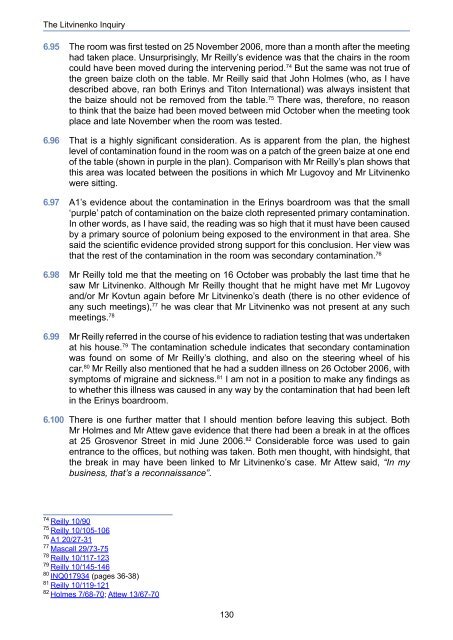The Litvinenko Inquiry
JIEp7Zyr
JIEp7Zyr
Create successful ePaper yourself
Turn your PDF publications into a flip-book with our unique Google optimized e-Paper software.
<strong>The</strong> <strong>Litvinenko</strong> <strong>Inquiry</strong><br />
6.95 <strong>The</strong> room was first tested on 25 November 2006, more than a month after the meeting<br />
had taken place. Unsurprisingly, Mr Reilly’s evidence was that the chairs in the room<br />
could have been moved during the intervening period. 74 But the same was not true of<br />
the green baize cloth on the table. Mr Reilly said that John Holmes (who, as I have<br />
described above, ran both Erinys and Titon International) was always insistent that<br />
the baize should not be removed from the table. 75 <strong>The</strong>re was, therefore, no reason<br />
to think that the baize had been moved between mid October when the meeting took<br />
place and late November when the room was tested.<br />
6.96 That is a highly significant consideration. As is apparent from the plan, the highest<br />
level of contamination found in the room was on a patch of the green baize at one end<br />
of the table (shown in purple in the plan). Comparison with Mr Reilly’s plan shows that<br />
this area was located between the positions in which Mr Lugovoy and Mr <strong>Litvinenko</strong><br />
were sitting.<br />
6.97 A1’s evidence about the contamination in the Erinys boardroom was that the small<br />
‘purple’ patch of contamination on the baize cloth represented primary contamination.<br />
In other words, as I have said, the reading was so high that it must have been caused<br />
by a primary source of polonium being exposed to the environment in that area. She<br />
said the scientific evidence provided strong support for this conclusion. Her view was<br />
that the rest of the contamination in the room was secondary contamination. 76<br />
6.98 Mr Reilly told me that the meeting on 16 October was probably the last time that he<br />
saw Mr <strong>Litvinenko</strong>. Although Mr Reilly thought that he might have met Mr Lugovoy<br />
and/or Mr Kovtun again before Mr <strong>Litvinenko</strong>’s death (there is no other evidence of<br />
any such meetings), 77 he was clear that Mr <strong>Litvinenko</strong> was not present at any such<br />
meetings. 78<br />
6.99 Mr Reilly referred in the course of his evidence to radiation testing that was undertaken<br />
at his house. 79 <strong>The</strong> contamination schedule indicates that secondary contamination<br />
was found on some of Mr Reilly’s clothing, and also on the steering wheel of his<br />
car. 80 Mr Reilly also mentioned that he had a sudden illness on 26 October 2006, with<br />
symptoms of migraine and sickness. 81 I am not in a position to make any findings as<br />
to whether this illness was caused in any way by the contamination that had been left<br />
in the Erinys boardroom.<br />
6.100 <strong>The</strong>re is one further matter that I should mention before leaving this subject. Both<br />
Mr Holmes and Mr Attew gave evidence that there had been a break in at the offices<br />
at 25 Grosvenor Street in mid June 2006. 82 Considerable force was used to gain<br />
entrance to the offices, but nothing was taken. Both men thought, with hindsight, that<br />
the break in may have been linked to Mr <strong>Litvinenko</strong>’s case. Mr Attew said, “In my<br />
business, that’s a reconnaissance”.<br />
74<br />
Reilly 10/90<br />
75<br />
Reilly 10/105-106<br />
76<br />
A1 20/27-31<br />
77<br />
Mascall 29/73-75<br />
78<br />
Reilly 10/117-123<br />
79<br />
Reilly 10/145-146<br />
80<br />
INQ017934 (pages 36-38)<br />
81<br />
Reilly 10/119-121<br />
82<br />
Holmes 7/68-70; Attew 13/67-70<br />
130


